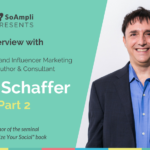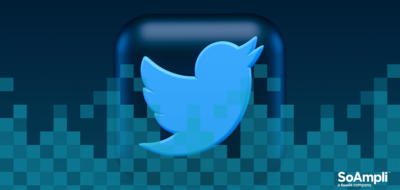When we first launched SoAmpli back in 2014, few people were familiar with the concept of social selling, employee advocacy or influencer marketing for B2B brands. The number of such company-wide programmes was limited, and organisations that wanted to increase brand awareness while helping sales teams find more prospects and move conversations down the funnel faster didn’t have much of a benchmark to refer back to.
In this landscape, it wasn’t hard for us to start conversations with pioneering experts who were talking about this type of sales and marketing strategies on social media. Among these “early adopters”, Neal Schaffer.
Neal is a global leader in teaching, training and consulting, specialised in helping companies with their business use of social media. This ranges from being an author – he has written three books, including the first and definitive book on creating a social media strategy called “Maximize Your Social” – to teaching social media marketing and social selling to executives at Rutgers Business School as well as the Irish Management Institute and speaking at events all over the world. He is currently writing his next book helping businesses with influencer marketing tentatively entitled “The Business of Influence.”
Not too long ago, we had the pleasure to sit down with Neal to discuss all things lead generation on social media, social selling and influencer marketing. Below, the first part of that fascinating interview…
Q: Time and time again you have been recognised as a top influencer on all things social media marketing and social selling. How did it all start?
In order to yield influence in digital and social, I believe that you really need to have something to say and be a content creator. For me, this started with LinkedIn. My background before social media was B2B sales and business development, but in 2008 I got to a point in my career where I was looking for a change. As I was using LinkedIn as a business tool to build my network on a daily basis, I became something of an expert, answering questions that people had about the platform. After a while, I started writing a blog on the topic; it was called “Your Expert Answers to Your LinkedIn Questions”. And that’s how it all started!
In those days, the terms social selling or employee advocacy didn’t exist yet, and people thought about social media primarily for job searching, online networking and professional branding.
In 2009 I published my first book, called “Windmill Networking – Understanding, Leveraging and Maximizing LinkedIn”, followed by my second book “Maximizing LinkedIn for Sales and Social Media Marketing” in 2011. But as time passed, I realised I didn’t want to be a one-trick pony, only writing about LinkedIn, especially as I believe the needs of the market are not dependent on just one social network. So, in 2013 I wrote another book based on my social media strategy consulting experience, “Maximize Your Social”.
Q: Can you walk us through your “social media routine”? What social media channels do you find most effective to build your business?
Well, when I look at Google Analytics for my company’s website, I can see that Twitter has traditionally been my top source of traffic from social media and therefore that’s where I tend to spend most time on. It’s also the one network where I can engage with anybody, since it’s so open, and it’s where I have the most followers and therefore I receive the most engagement. So, first thing in the morning I look at my mentions and direct messages on Twitter; then I’ll go to LinkedIn and finally Facebook and Instagram. I try to find five or ten minutes a day just to see if there are any mentions, retweets, likes, comments that I should be keeping tabs on.
Then I move to my web properties (MaximizeSocialBusiness.com, NealSchaffer.com), I monitor my editorial calendar, I check if there are any new comments, etc… I begin the day in “moderation mode”, for lack of a better word! After my engagement time, I have my own community building time, where I look for people to connect with, to follow, or to consider as new sources for content curation.
After that – and only then! – I go to my inbox. I am a big fan of email, and it’s a critical channel that I can’t forget, but I try to focus on that engagement and community building before I get to urgent work matters. Each of the things I talked about are between 5 and 15 mins a piece; then I have my golden time, aka the morning until lunch, when I focus on client work. Then, during the afternoon, I’ll go back to my social channels and see if there is anything else I need to jump on.
I try to limit the engagement and email checks to twice a day, as much as I can.
There are then additional and less frequent social media routines. For example, I do a lot of block content curation, finding enough content to share for a week. On a monthly basis I will also review my sources, because they are critical and I want to make sure that I’m not missing out on any up and coming new content out there.
Finally I try to make daily time for content creation, whether it be blog posts or working on my new book. Unfortunately, as with most marketers, finding time for long-form content creation is a constant struggle!
My 4th Book The Business of Influence: How to leverage #InfluencerMarketing for your business and yourself. Details: https://t.co/1oRQoTOKgX pic.twitter.com/KUzh9rfGXj
— Neal Schaffer (@NealSchaffer) 18 October 2017
Q: In your experience, how should B2B businesses approach and devise their social media strategy?
Simply put, I think that companies should not put social media in silos. They should start by looking at their corporate strategy, and then think about where social media can fit into that. Social media can complement every aspect of your business, from using social listening for R&D purposes or customer support, to media relations using Twitter, to sales, marketing, and pretty much everything in between. So it’s really important to get strategic and focus on the number one thing that you’re trying to do – i.e. increasing sales by 10%, get 10 new customers per month, or whatever it might be – and think about how you can utilise social media to get there faster.
So, whenever I talk about social media strategy with my clients and they tell me what their objective is, the first question I ask is: “How are you doing that now?”.
That gives me an idea of what they could be doing on social media and what they’re not doing right now. Then, based on that, we start to look at networks, target user personas, content, advocates (both internal and external) and influencers. That’s really the approach I want all businesses – whether they’re B2B or not – to take. At the end of the day, every B2B business I work with ends up either producing or curating a lot more content than they originally did. I would also say that at this point in 2018 you really need to have both a paid component as well as an influencer component of your social media strategy.
Q: What do you suggest to businesses wanting to tie their social media efforts to actual ROI?
To me, ROI goes hand in hand with the strategy and the overall business objectives. So, if you’re trying to increase sales by X%, or increase the number of customers, or whatever else you’re trying to do, you need to tie a KPI or some way of measuring your success to that. For B2B companies, if your salespeople aren’t logging their successes that happen on social media in your CRM system, you’re never going to see this correlation. So you need to make sure that even anecdotal incidents that help prove the ROI of your investment in social media get logged.
At present, there is no one social media tool that is going to magically calculate the ROI of your strategy for you, because everyone’s objectives and therefore everyone’s KPIs are different, and at the same time companies need to be truly omnichannel.
With time, I think that a social media presence will become much like a website presence or an employee advocacy programme; it’s part of your infrastructure, it’s part of the way of doing business in the digital world we currently live in.
Stay tuned for the second part of our exclusive interview!
Interested in lead generation on social media, social selling and influencer marketing? Discover more expert interviews here:







